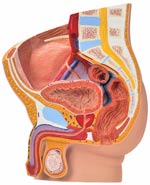Let Utah Valley's Pelvic Floor Rehabilitation Experts Explain Why Kegels Don't Work...
Then Show You How They Can!
A Kegels Bladder Scan is a Technological Break-Through in Pelvic Floor Muscle Rehabilitation for Women after Child-Birth and Men after Prostate Surgery to Treat Urinary Stress Incontinence
While I was at a lunch meeting with a group of doctors and nurses at a large women's health clinic I was surprised to hear one OB-GYN tell me:
"Kegels don't work for my patients after child-birth...
So I do a surgical procedure that fixes the problem."
I had to wonder how he came to this conclusion... Yes, it is true that many women fail to regain their bladder control after child-birth. But how many of these mothers have gone through a well-designed rehabilitation program? Might I suggest that most people who fail, do so because of a lack of specific knowledge and training. Someone told them to "do Kegels" and they tried... but don't really have the "know-how."
Personally, I have yet to find a new patient with bladder control problems who performs Kegels properly. During their first attempt to squeeze the pelvic floor muscles, we never see the correct lifting-action during Kegels bladder scan. They contract their hip muscles, thigh muscles or buttocks muscles, or they perform a valsalva manuever with their abdominal muscles. So, maybe what the doctor quoted above should of said is that: "Counterfeit kegels don't work for my patients..."
We Must Overcome Five Main Obstacles to Succeed
I have written this article to describe five main obstacles to successful rehabilitation of the pelvic floor muscles: 1) the elusive inner-squeeze, 2) non-compliance, 3) faulty training and other damaging activities, 4) sacroiliac joint problems or low back pain, and 5) procrastination or not starting until it's too late. I will discuss each problem and then provide a solution. First let's discuss "the elusive inner-squeeze."
Problem #1: The elusive inner-squeeze
Kegels are difficult to perform correctly without precise biofeedback and coaching. Research has shown that over half of all women are unable to produce a correct contraction of the pelvic floor muscles after verbal or written instructions from a health professional. Unlike your "six-pack" muscles (abs) or your glutes muscles (buttocks), you cannot see the pelvic floor muscles contract. And because of their position, it is "awkward" or embarrassing to touch the PFM to feel the contraction.
Solution: Kegels bladder scans & expert coaching
We use a BLADDER SCAN to make sure you find your inner-squeeze: When you see yourself perform the proper squeeze to "elevate" the pelvic floor, the video images let you know you are doing it right. This innovative use of ultrasound imaging (sonography) is the best type of biofeedback muscle rehabilitation. You will see the lifting-action during a proper Kegels performance on a video monitor.
We also offer Expert Coaching to help you find your inner-squeeze: You will get precise coaching from a Kegels expert. Dr. Knudsen has nearly a decade of experience performing bladder scans and coaching Kegels. Although PFM exercises seem simple enough and many women wonder why they are being referred to a physical therapist to learn them, the "inner-squeeze" is elusive or difficult to find. The first step is to learn the proper technique and practice enough to make the link between the brain and muscle stronger. Full awareness (in a meditative state) is employed in the early stages of retraining before progressing more spontaneous PFM contractions.
Finding Your Inner-Squeeze
During
Pelvic Floor Muscle Rehabilitation
Problem #2: Non-compliance
Treatment is often unsuccessful because of exercise non-compliance: Most people forget to perform Kegels as prescribed. This means that even if you "know how" to perform the exercise correctly, if you do not follow the exercise protocol you will fail. In one study patients completed only 15% of their assigned home exercises.
Solution: External cue to action
For exercise compliance we use an external cue to action. We send a text message to your cell phone as an "alert" to perform your Kegels rountine. You would then be instructed to listen to a recording that provides precise coaching.
Problem #3: Faulty training and other damaging activities
Kegels that are done wrong... cause you to leak more. Here's why... To prevent leakage, you must squeeze precisely to lift the pelvic floor. If you train using the wrong method (without finding your true inner-squeeze), then you will not make progress in your ability to stay dry.
What's worse, if you are performing what is called a valsalva maneuver during your Kegels workouts, then your condition will worsen. Performing a valsalva pushes the pelvic floor down. This action strains and weakens these Kegel muscles causing more bladder leakage.
Solution: Bladder Scans & expert coaching
Video biofeedback is the key to your success as the bladder scan lets you and me know when your Kegels performance produces the proper lifting-action (via the pelvic floor muscles). We can also measure your inner-squeeze holding time (in seconds), which is an important factor in your successful rehabilitation. Furthermore there are other activities that damage your pelvic floor that we will address during your visit.
Problem #4: Misalignment in the sacroiliac joint and low back pain
Studies show an association between back pain and incontinence. Research has shown that people with sacroiliac joint pain often have problems with urinary incontinence (inability to control the bladder). One reason for this may be the way the muscles around the bladder work with other muscles that produce inner core stability. The pelvic floor muscles not only give strength to structures holding the bladder and urethra in place but they also help to hold the pelvic bones, sacrum, and lumbar vertebrae together.
Your physician or nurse and most physical therapists will likely overlook this major complicating factor because it is not something they are trained to fix or evaluate. Yet, one study identified that 38% of women with stress urinary incontinence also have low back pain (LBP), and guess which problem startedf first? The overwhelming majority of these women report having LBP as their first symptom, meaning that the problem in the lower back may be the cause of their incontinence.
How does this happen? The sacroiliac joint, which is located in the lower back between the spine and hip joint, sometimes gets moved out of alignment, often from childbirth, surgical procedures, falls or trauma. More specifically, we have identified a commonly occuring partial dislocation of the sacroiliac joint as the root cause in these cases. Since self-correction is rare, this problem can lead to weakened pelvic muscles and compromised ligaments (these particular ligaments are bands of soft tissue that hold the sacrum, pelvic bones, and lower lumbar vertebrae together).
Solution: Gentle stretching to correct mis-aligned bones
You will likely see immediate improvement when this partial dislocation (or the position of your pelvic bones, sacrum, and lumbar vertebrae) is corrected. It is actually easier and gentler than you think. And, we will also show you how to perform self-correction exercises at home to keep your pelvic girdle symmetrical between visits.
Problem #4: Procrastination or not starting until it's too late.
Not knowing when to get started with a Kegels exercise program or putting it off until later (hoping that maybe it will just get better on its own) is setting yourself up for failure.
Solution: Prevention is the key
It is so much easier to learn how to perform Kegels when your pelvic floor muscles are healthy... You don't want to attempt to learn how when you are incontinent. So, we get started before you have a problem or before your problem worsens. The easiest time to find your inner-squeeze is during the first part of pregnancy or before prostatectomy or other surgeries. Building up these muscles and training your brain and nerves to perform the task will make it so much easier compared to after the problem worsens.
We will check your performance at each stage of your pregnancyand after child-birth or before and after any surgeries according to a pre-determined protocol that has been established to produce superior results.
Remember, perfect practice...
makes perfect!
What to expect on your first visit:
Your first visit includes the following:
1) a discussion about causes and treatments of stress urinary incontinence in males or females;
2) detailed verbal instruction about pelvic floor muscle identification and contraction;
3) proper pelvic floor muscle contraction by the patient measured using a biofeedback bladder scan;
4) a pelvic floor muscle exercise instruction sheet informing the patient to perform these exercises for ten minutes twice a day;
5) a diagram of female or male pelvic floor muscles; and
6) verbal encouragement to perform pelvic floor muscle exercises with suggestions of potential exercise times based on each individual’s lifestyle.
FAQs:
Question: "I don't want another internal pelvic exam... Is that part of the doctor's evaluation during my visits?"
Answer: "No. We do not measure the pelvic floor contraction by inserting a finger into any body cavity; the bladder scan tells us precisely what we need to know to correct your Kegels performance."
Question: "Do I have to undress?"
Answer: "No. We can do the bladder scan in your street clothes (changing into a hospital gowns is not necessary). We only need to place a small ultrasound device on your lower tummy to perform the bladder scan."
Question: "Does it really work?"
Answer: "Yes. This type of biofeedback program has been shown to work well in scientific studies."



 Case Study:
Case Study: